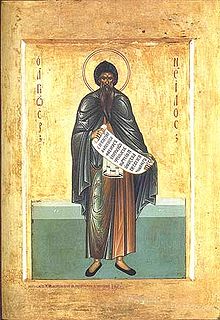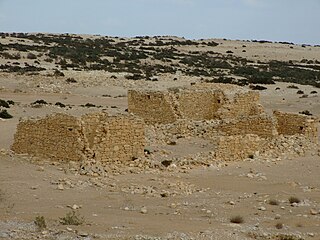
Saint Nilus the Elder of Sinai was one of the many disciples and stalwart defenders of St. John Chrysostom.

The ancient city of Halasa or Chellous, Elusa (Ελουϲα) in the Byzantine period, was a city in the Negev near present-day Kibbutz Mash'abei Sadeh that was once part of the Nabataean Incense Route. It lay on the route from Petra to Gaza. Today it is known as Haluza, and during periods of Arab habitation it was known as al-Khalūṣ and Al-Khalasa.

Al-Khalasa, was a Palestinian village, located 23 kilometers southwest of the town of Beersheba. The village stood at the site of an ancient town from the Nabatean, Roman, Byzantine, and the beginning of the Early Muslim period. The ancient city, founded by the Nabateans, is known from Greek and Roman sources as "Halasa" or "Chellous", and later as "Elusa", one of the Byzantine administrative centers in the Negev Desert. Still important in the century of the Muslim conquest, it was deserted not long after. The site was repopulated by Bedouin in the early twentieth century, after western archaeologists took an interest in it. In October 1948, it was captured by Israel during the 1948 Arab-Israeli War. The population of al-Khalasa is unknown, but all of the inhabitants were Muslims, from the al-Azizma tribe.

Elusa is a genus of moths of the family Noctuidae erected by Francis Walker in 1859.

The Elusates were an Aquitani tribe dwelling in the modern Gers department, around present-day Eauze, France during the Iron Age and the Roman period.

Eauze is a commune in the Gers department in southwestern France.

The former Roman Catholic Metropolitan Archdiocese of Eauze, in Aquitaine, south-west France, existed from circa 300 to 879.

Elusa semipecten is a species of moth of the family Noctuidae first described by Charles Swinhoe in 1901. It is found in the Australian states of New South Wales and Queensland.
Elusa ceneusalis is a species of moth of the family Noctuidae. It was described by Francis Walker in 1859 and is known from Sundaland, the Philippines, Sulawesi, Queensland, and the Bismarck Islands.
Elusa cyathicornis is a species of moth of the family Noctuidae. It was described by Francis Walker in 1862 and is known from Borneo.
Elusa diloba is a species of moth of the family Noctuidae. It was described by George Hampson in 1909, and is known from Borneo.
Elusa dinawa is a species of moth of the family Noctuidae. It was described by George Thomas Bethune-Baker in 1906, and is known from New Guinea.
Elusa flammans is a species of moth of the family Noctuidae. It was described by Warren, 1913. It is found in New Guinea.
Elusa ignea is a species of moth of the family Noctuidae. It was described by Warren in 1913, and is known from New Guinea.
Elusa incertans is a species of moth of the family Noctuidae. It was described by George Thomas Bethune-Baker in 1906, and is known from New Guinea.
Elusa inventa is a species of moth of the family Noctuidae. It was described by Emilio Berio in 1977, and is known from China.
Elusa orion is a species of moth of the family Noctuidae. It was described by Walter Karl Johann Roepke in 1956, and is known from New Guinea.
Elusa subjecta is a moth of the family Noctuidae first described by Francis Walker in 1865. It is found in Sri Lanka, India and the Andaman Islands.
Pultenaea elusa, commonly known as elusive bush-pea, is a species of flowering plant in the family Fabaceae and is endemic to a small area of New South Wales. It is a low shrub with sharply-pointed linear leaves, and dense clusters of yellow to orange and red to purple flowers. It has not been seen since 1938.







